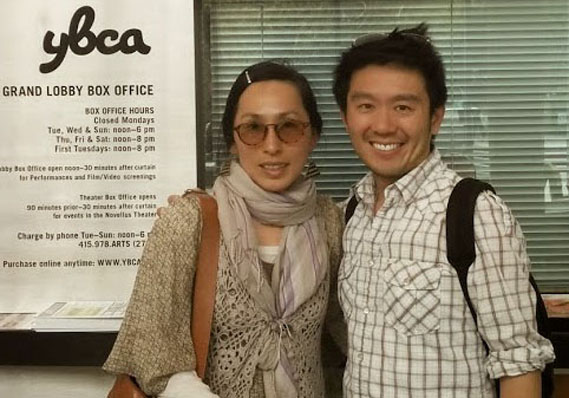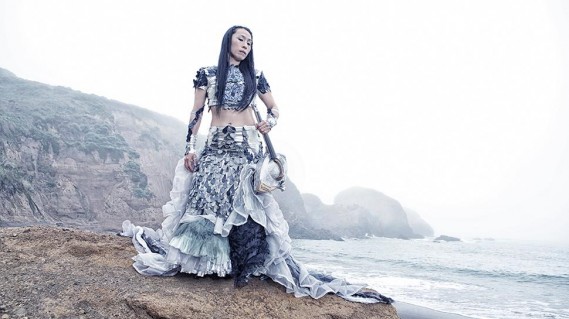Artist to Artist: Byron Au Yong Interviews Dohee Lee
As part of our Artist-to-Artist conversation series, Byron Au Yong (2009 Performing Arts) sat down with Dohee Lee (2013 Performing Arts) to learn more about Lee’s project MAGO, an immersive performance that blends traditional Korean arts and shamanism in a modern context. Drawing on Lee’s own family history and the current political and environmental crisis taking place in the South Korean island where she was born, Lee weaves myth, ritual, ancestors, memory, present and future into a powerful performance journey.
Byron Au Yong: You’ve been developing MAGO for a few years. This past year, there have been four seasonal ritual performances at Yerba Buena Center for the Arts, plus performances throughout the Bay Area related to this project. How have you been able to sustain this development and who has influenced your process?
Dohee Lee: Mago represents my creator goddess and my ancestors. They guide me in my dreams and during research. Anna Halprin [a pioneer in dance healing] encourages me to create my own way as an artist. She always points to my cultural background as a great resource. Her way of thinking and working gives me space to be who I am.
When I was invited by Yerba Buena Center for the Arts to develop the MAGO project as a year-long process, I focused on seasonal rituals with traditional and contemporary influences. I planned different forms to encourage audiences to become part of the ritual. With an Opening Ritual based on traditional Korean rites, people mostly watch and follow.
MAGO‘s Winter Ritual introduced individual participation. One by one, people lined up with the names of family members they wanted to remember. Everyone connected with their ancestors while the musicians and I played and sang for eight hours without stopping.
For the Spring Ritual, the MAGO team gave free workshops on water, breath, sound, singing and movement. We gathered and prepared the ritual together, requiring the most participation. With these seasonal rituals, I could feel the potential of creating a new performance from the experience of traditional, modern and contemporary practices.

Dohee Lee and Byron Au Yong at Yerba Buena Center for the Arts. Dohee Lee’s MAGO premieres at Yerba Buena, November 14-15, 2014.
Byron: These cumulative rituals sound like a great way to expand possibilities as an artist. During your research, I know you reached towards your roots by returning to your birthplace in South Korea. How did spending time on Jeju Island affect MAGO?
Dohee: From my Jeju journey, I realized two things that enrich the stories and structure of my performance. The first is the silent part of memories and the feeling of absence. I also discovered the Crow as a messenger by learning more about the April 3rd Massacre [nearly 30,000 people from Jeju Island were killed during a year-long rebellion known as the Jeju Uprising that began in April 1948].
My research in Jeju brought memories I had never noticed before. It was about a renewed awareness and intention to look at my hometown differently. I used to feel happy to see my grandparents and hometown. I used to feel excited to see my relatives. I used to feel joy to see the beautiful hills, mountains and ocean. But this time was different.
I grieved. I was shocked. I was horrified. These were new emotions. Now, I feel more deeply connected to my hometown: where I’m from, who I am, why I am, and what I am doing.
Since my trip to Jeju was to do research and work on a documentary film about the April 3rd Massacre in Jeju, I had to warm up my memories; but, unfortunately, what I remember is the silence of the village.
I could smell and taste that thick silence.
It seemed like the elders never wanted to bring out the stories to their children and grandchildren because they did not want them to have the same trauma. It was not only my grandparents who were silent. Many people from my grandparents’ generation did not want to talk about the massacre. They did not want their children to suffer from the incident. I wanted to talk about this silence.
A big part of this journey was to learn how I could break the silence. How could I—from a new and younger generation, who had never had this incident in my life—tell this memory for future generations? This is why I put this story into MAGO. I needed to connect my past with their history; with stories that access and meet the future.
Byron: And a crow became your messenger?
Dohee: Yes, crows are messengers. Whenever I visit Jeju, I notice so many crows that are so huge. They fly by me with no fear. They watch. I pay attention to them.
Most of they places I found them were massacre sites.
Crows are protectors of the land, soul and memories. They ask, “What do you see? What do you hear? What is being ignored?” These were their constant questions.
I became aware of a connection between time—from past to present—from the Massacre to the Naval Base being built in Jeju now that is currently destroying people’s lives, their belief system and their beautiful island home.
This is not the past. This is the present and the future. This is what Crow does in the performance. In MAGO, I transform into the Crow as a connector between land, ancestors, nature and myself.
Byron: Do you consider this performance to be a protest?
Dohee: This performance ritual is action. This is my action. I share stories, feelings and imagination. Art brings people together to share and empower in many ways.
Byron: With the MAGO project, you’ve brought people together by working with various artists and community performers. How do you collaborate?
Dohee: When working with collaborators, there’s a mutual way of exchanging. It’s a learning process. For MAGO, I collaborate with an animation artist, visual artist, computer programmer, set designer, lighting designer, costume designer and instrument builder to create time travel through myth to past, present, dreams and future.
This performance is a ritual. In ritual, the musician’s role is to encourage and support the shaman while they address messages to the spirits. We make dreams real through different art forms. Adria and the other roles are similar to the traditional roles of musicians.
VIDEO: MAGO preview
Byron: You’re deeply connected to traditional and contemporary influences. I’m fascinated by the technology in your performances. How do you and Adria work together?
Dohee: Working with sound designer and co-musical director Adria Otte is crucial because sound carries lots of stories and supports the energy of the performance. We have been working together on MAGO since 2011. We visited Jeju for research. Our intent was to understand Jeju’s Ocean Ritual. How could we bring this ritual into our own way of performance?
I also collaborated with sound designer and programmer Donald Swearingen. He invented SensorPlay, a wearable media control system developed with Pamela Z. Donald and I worked on SensorPlay to add more focused movements. Involving technology can be like dreaming; it’s where the spiritual and magical world gain strength.
Byron: I’m excited to experience your discoveries. And after MAGO? What comes next?
Dohee: My next step is to work with people to find their own myths, dreams, stories and histories; to research and create a performance about land, people, nature and themselves called ARA: Waterways, Time Weaves.
Dohee Lee premieres MAGO at Yerba Buena Center for the Arts in San Francisco, November 14-15. Tickets are available online. Read a preview of the work by dance critic Jai Arun Ravine here.
Byron Au Yong and Aaron Jafferis’ Creative Capital project, Stuck Elevator, premiered at the American Conservatory Theatre in San Francisco in April 2013, then toured to the International Festival of Arts & Ideas in New Haven in June 2013.



